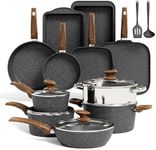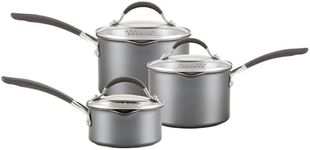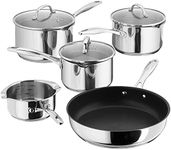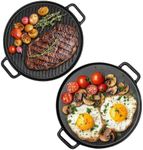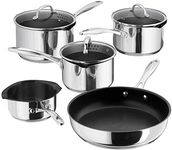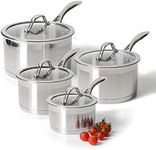Buying Guide for the Best Induction Cookware Sets
Choosing the right induction cookware set is crucial for anyone who wants to make the most out of their induction cooktop. Induction cooking is efficient and fast, but it requires cookware that is compatible with the induction technology. When selecting an induction cookware set, it's important to consider factors such as material, size, weight, and compatibility to ensure that the cookware meets your cooking needs and preferences. Understanding these key specifications will help you make an informed decision and enhance your cooking experience.MaterialThe material of induction cookware is important because it affects heat conductivity, durability, and compatibility with induction cooktops. Common materials include stainless steel, cast iron, and non-stick aluminum. Stainless steel is durable and often has an aluminum or copper core for better heat distribution. Cast iron retains heat well but is heavy. Non-stick aluminum is lightweight and easy to clean but may not be as durable. Choose a material based on your cooking style: stainless steel for versatility, cast iron for slow cooking, and non-stick for easy cleanup.
Induction CompatibilityInduction compatibility is crucial because not all cookware works with induction cooktops. Induction cooktops use magnetic fields to heat pots and pans, so the cookware must have a magnetic base. To check compatibility, see if a magnet sticks to the bottom of the cookware. Most induction-compatible cookware will be labeled as such. Ensure that the entire set is compatible to avoid any inconvenience. If you already have an induction cooktop, make sure the cookware set you choose is specifically designed for induction use.
Size and Number of PiecesThe size and number of pieces in a cookware set determine how versatile it will be for your cooking needs. Sets can range from a few essential pieces to comprehensive collections. Consider the size of your household and the types of meals you typically prepare. A basic set might include a frying pan, saucepan, and stockpot, while larger sets offer more specialized pieces. Choose a set that provides the right balance of pieces for your cooking habits without overwhelming your kitchen space.
WeightThe weight of cookware affects how easy it is to handle and use. Heavier cookware, like cast iron, retains heat well and is great for slow cooking, but it can be cumbersome to lift and move. Lighter cookware, such as aluminum, is easier to handle but may not retain heat as effectively. Consider your physical comfort and cooking style when choosing the weight of your cookware. If you prefer quick, high-heat cooking, lighter cookware might be more suitable, while heavier options are better for slow, even cooking.
Handles and LidsHandles and lids are important for safety and convenience. Look for cookware with sturdy, heat-resistant handles that are comfortable to grip. Some handles are designed to stay cool, which can be a valuable feature. Lids should fit snugly to retain moisture and heat. Glass lids allow you to monitor cooking without lifting the lid, which can be helpful. Consider how often you cook with lids and whether you need them to be oven-safe, as this can influence your choice.
